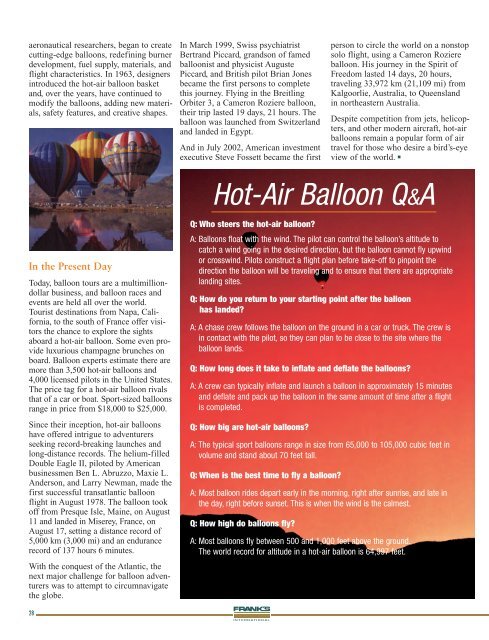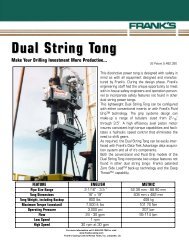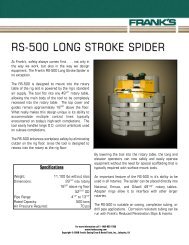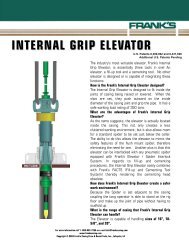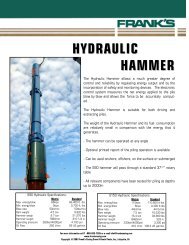Master Mag Templet - Frank's International, Inc.
Master Mag Templet - Frank's International, Inc.
Master Mag Templet - Frank's International, Inc.
You also want an ePaper? Increase the reach of your titles
YUMPU automatically turns print PDFs into web optimized ePapers that Google loves.
aeronautical researchers, began to create<br />
cutting-edge balloons, redefining burner<br />
development, fuel supply, materials, and<br />
flight characteristics. In 1963, designers<br />
introduced the hot-air balloon basket<br />
and, over the years, have continued to<br />
modify the balloons, adding new materials,<br />
safety features, and creative shapes.<br />
In the Present Day<br />
Today, balloon tours are a multimilliondollar<br />
business, and balloon races and<br />
events are held all over the world.<br />
Tourist destinations from Napa, California,<br />
to the south of France offer visitors<br />
the chance to explore the sights<br />
aboard a hot-air balloon. Some even provide<br />
luxurious champagne brunches on<br />
board. Balloon experts estimate there are<br />
more than 3,500 hot-air balloons and<br />
4,000 licensed pilots in the United States.<br />
The price tag for a hot-air balloon rivals<br />
that of a car or boat. Sport-sized balloons<br />
range in price from $18,000 to $25,000.<br />
Since their inception, hot-air balloons<br />
have offered intrigue to adventurers<br />
seeking record-breaking launches and<br />
long-distance records. The helium-filled<br />
Double Eagle II, piloted by American<br />
businessmen Ben L. Abruzzo, Maxie L.<br />
Anderson, and Larry Newman, made the<br />
first successful transatlantic balloon<br />
flight in August 1978. The balloon took<br />
off from Presque Isle, Maine, on August<br />
11 and landed in Miserey, France, on<br />
August 17, setting a distance record of<br />
5,000 km (3,000 mi) and an endurance<br />
record of 137 hours 6 minutes.<br />
With the conquest of the Atlantic, the<br />
next major challenge for balloon adventurers<br />
was to attempt to circumnavigate<br />
the globe.<br />
28<br />
In March 1999, Swiss psychiatrist<br />
Bertrand Piccard, grandson of famed<br />
balloonist and physicist Auguste<br />
Piccard, and British pilot Brian Jones<br />
became the first persons to complete<br />
this journey. Flying in the Breitling<br />
Orbiter 3, a Cameron Roziere balloon,<br />
their trip lasted 19 days, 21 hours. The<br />
balloon was launched from Switzerland<br />
and landed in Egypt.<br />
And in July 2002, American investment<br />
executive Steve Fossett became the first<br />
person to circle the world on a nonstop<br />
solo flight, using a Cameron Roziere<br />
balloon. His journey in the Spirit of<br />
Freedom lasted 14 days, 20 hours,<br />
traveling 33,972 km (21,109 mi) from<br />
Kalgoorlie, Australia, to Queensland<br />
in northeastern Australia.<br />
Despite competition from jets, helicopters,<br />
and other modern aircraft, hot-air<br />
balloons remain a popular form of air<br />
travel for those who desire a bird’s-eye<br />
view of the world. ■<br />
Hot-Air Balloon Q&A<br />
Q: Who steers the hot-air balloon?<br />
A: Balloons float with the wind. The pilot can control the balloon’s altitude to<br />
catch a wind going in the desired direction, but the balloon cannot fly upwind<br />
or crosswind. Pilots construct a flight plan before take-off to pinpoint the<br />
direction the balloon will be traveling and to ensure that there are appropriate<br />
landing sites.<br />
Q: How do you return to your starting point after the balloon<br />
has landed?<br />
A: A chase crew follows the balloon on the ground in a car or truck. The crew is<br />
in contact with the pilot, so they can plan to be close to the site where the<br />
balloon lands.<br />
Q: How long does it take to inflate and deflate the balloons?<br />
A: A crew can typically inflate and launch a balloon in approximately 15 minutes<br />
and deflate and pack up the balloon in the same amount of time after a flight<br />
is completed.<br />
Q: How big are hot-air balloons?<br />
A: The typical sport balloons range in size from 65,000 to 105,000 cubic feet in<br />
volume and stand about 70 feet tall.<br />
Q: When is the best time to fly a balloon?<br />
A: Most balloon rides depart early in the morning, right after sunrise, and late in<br />
the day, right before sunset. This is when the wind is the calmest.<br />
Q: How high do balloons fly?<br />
A: Most balloons fly between 500 and 1,000 feet above the ground.<br />
The world record for altitude in a hot-air balloon is 64,997 feet.


